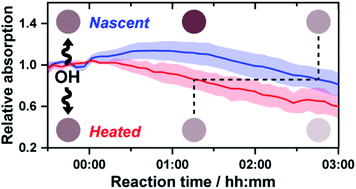Emerging investigator series: heterogeneous OH oxidation of primary brown carbon aerosol: effects of relative humidity and volatility†
Abstract
The climate forcing of light-absorbing organic aerosol, or brown carbon (BrC), emitted from biomass burning may be significant but is currently poorly constrained, in part due to evolution during its residence time in the atmosphere. Here, the effects of ambient relative humidity (RH) and particle volatility on the heterogeneous OH oxidation of primary BrC were investigated in laboratory experiments. Particles were generated from smoldering pine wood, isolated from gaseous emissions, conditioned at 200 °C in a thermal denuder to remove the most volatile particulate organics, and injected into a smog chamber, where they were conditioned at either 15 or 60% RH and exposed to gas phase OH radicals. Changes in composition were monitored using an aerosol mass spectrometer (AMS), and changes in absorption at 405 nm were monitored using a photoacoustic spectrometer. Heterogeneous OH oxidation of nascent BrC at 60% RH resulted in steady increases in the AMS fraction of CO2+ (associated with carboxylic acids), the O : C ratio, and the carbon oxidation state, consistent with extensive functionalization. These composition changes corresponded first to very rapid absorption enhancement and then bleaching. Net bleaching was observed after the equivalent of 10 h residence time in the atmosphere. The evolution did not depend strongly on RH, consistent with homogeneously well-mixed primary BrC even at 15% RH at room temperature. In contrast, the evolution did depend strongly on the pre-treatment of the particles, such that only bleaching occurred for particles treated at 200 °C. This suggests that lower volatility constituents of ambient primary BrC have less capacity for absorption enhancement in the atmosphere upon heterogeneous oxidation, potentially as they are already more functionalized and/or oligomeric.

- This article is part of the themed collections: Emerging Investigator Series and Organic Aerosols


 Please wait while we load your content...
Please wait while we load your content...